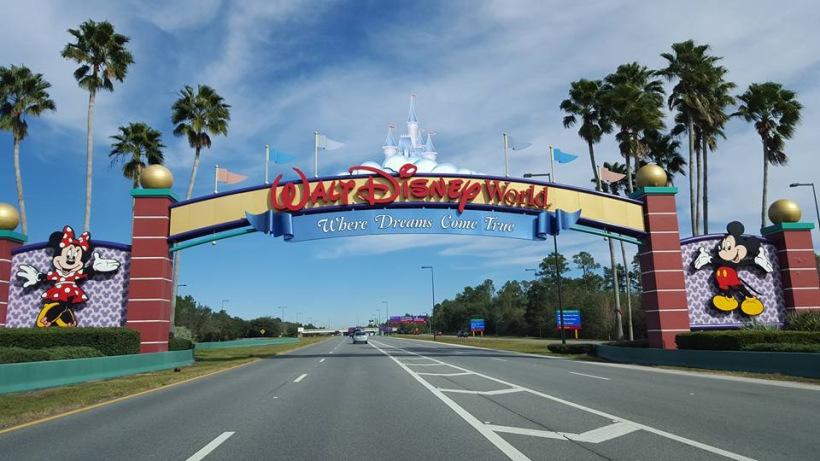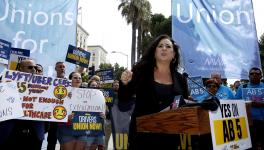How ‘the Happiest Place on Earth’ is Built on the Misery of Thousands of Workers

Image Coutesy: Disney Fanatic
Many of the tourists bringing billions of dollars to Disneyland may agree with description of the theme park as the "happiest place on earth". Walt Disney is often quoted as saying, “You can design and create, and build the most wonderful place in the world. But it takes people to make the dream a reality.” But for the people who “make the dream a reality” - the workers of Disneyland - the park is anything but a source of boundless joy.
Last week, Senator Bernie Sanders spoke at an event in Anaheim, California, whose tax-payers had coughed up $267 million in 2016 as subsidies to Disney after the latter threatened to pull out of a project to build a luxury hotel in the city. He highlighted the vast disparity between the profits of the company and the pathetic condition of the workers.
Hired at less than the living wages, most of the workers of this iconic park live in cramped overcrowded houses, are unsure about getting enough food to eat, and are unable to pay for their medical needs.
While Disney's profits increased by a margin of 582% between 2000 and 2017 - from $1.4 billion to $9.4 billion - the wages of the workers in the same period declined by 15%. Adjusted to 2017 dollar value, the average hourly wage of Disneyland employees dropped from $15.80 in 2000 to $13.36 in 2017, and the median hourly wage dropped from $13.23 to $11.15, according to a survey of the workers employed at the Disneyland resort in Anaheim.
To meet the basic needs of food, healthcare, childcare, transportation, housing and other basic living expenses of a family of four, each of the two working parents in a family will need to earn at least $18.26 an hour, according to a 2017 report by California Budget and Policy Center.
As most of them are paid well below this living wage, almost three-quarters of the workers in Disneyland are unable to meet their basic living expenses, the study showed. More than one in 10 of the workers have been homeless in the last two years, while over half of them fear that being unable to pay rent on time, they will be evicted from their homes - most of which are overcrowded.
18% of the population of the state of California lives in overcrowded housing. But among those working for the Disneyland, the figure is disproportionately higher, with 52% of them cramped into tiny spaces, “squeezing too many family members, roommates or even multiple families into a unit that is too small to accommodate the number of Occupants,” states the report “Working for the Mouse: A survey of Disneyland resort employees”.
More than 68% of the workers have reported food insecurity. The plight of those employees who have to pay for child care is worse, with 79% reporting food insecurity. 59% of the full-time workers reported that they had to skip meals or reduce the portions "because there wasn’t enough money for food".
A single mother, who works full time cooking for the wealthy customers who visit Disneyland from around the world, told the surveyors, “I often go for days with just one meal since I can’t afford more groceries. The food I buy is for my children and there isn’t usually enough for all three of us.. We often only survive off spaghetti since it’s so cheap. We can’t even get sauce for it.. just butter.”
Another full-time employee said, “I love working at the Disneyland resort. I get to make magic for people all around the world. But.. I lost 35 pounds in a matter of 2 months because I couldn’t afford to eat more than one meal a day.”
With the work schedule of 72% of the workers changing every week, 64% of Disneyland’s employees complained that they were unable to find a second job to supplement the insufficient income they earn there.
Further, 41% of full-time employees reported that they were in need of dental care, but were unable to afford it. Another 28% of the workers who needed eyeglasses or contact lens had to do without them for not being able to afford them. 28% had forego prescription medicines and another 22% could not afford the follow-up medical care they needed.
“I want to hear the moral defense of a company that makes $9 billion in profits, $400 million for their CEOs and have a 30-year worker going hungry,” Sanders said at Anaheim. The $267 million in subsidies was the largest tax-break given in the city’s history, and third largest subsidy received from State and local governments by any corporation in 2016. According to the Subsidy tracker of Good Jobs First, between 1991 and 2017, Walt Disney has received a total $842,945,687 in form of state and local subsidies. This figure does not include undisclosed subsidy values. .
Various unions have been struggling for a wage hike since last year. Early this year, on March 23, hundreds of unionized Disney workers, chanting “We work, we sweat, put a raise on our check”,and carrying picket signs calling to “End Disney Poverty”, marched to the entrance of an entertainment and shopping complex called Disney Springs, demanding a minimum wage of $15 per hour.
The previous month, as a punitive measure against the unionized workers who had refused to concede Disney’s wage proposal, the company withheld bonuses up to $1,000 from 41,000 unionized workers in California and Florida.
These bonuses were promised to them in January after the company gained $1.6 billion in its last quarter to due tax-cuts announced in December. The company had communicated to these workers that in order to have their bonuses released, they would have to accept Disney’s wage proposal by August 31.
The company offered to raise the wages of entry-level employees, who currently earn $11 per hour, to $13.25 immediately, and eventually to $15 dollars over the coming three years. This is the most ‘generous’ Disney has been and comes in a year when even if the minimum wages are immediately raised to $20 per hour, its CEO Robert Iger's compensation would be equal to the total wages of 5,230 Disney employees.
Rejecting these crumbs, the coalition of unions have demanded that all large employers in the State who receive huge government subsidies, and not only Disney, must be mandated to pay a minimum wage of $15 per hour by January 1, 2019. This, they demand, must be followed by a further rise of $1 on the 1st of January of every subsequent year until the end of 2022. “After an employee’s pay reaches $18 an hour, raises would be pegged to the cost of living,” the Hill reported.
The unions are seeking to put this demand as a measure in the Municipality ballot this November. The minimum signatures required to qualify their demand for the ballot was 13,510, or 10% of the city’s voters. On Saturday, when Bernie Sanders spoke in their support, 21,000 signatures had already been collected.
“The struggle that you are waging here in Anaheim is not just for you.. It is a struggle for millions of workers all across this country who are sick and tired of working longer hours for lower wages,” Bernie Sanders said while addressing the union workers.
Both Disney and the city’s Chamber of Commerce have opposed the measure, calling it too expensive.
Backing the Unions’ demand, Sanders said, “If a corporation like Disney has enough money to pay its CEO over $400 million in a four-year period, it has enough money to pay its workers $15 an hour.”
Get the latest reports & analysis with people's perspective on Protests, movements & deep analytical videos, discussions of the current affairs in your Telegram app. Subscribe to NewsClick's Telegram channel & get Real-Time updates on stories, as they get published on our website.

















